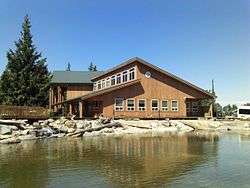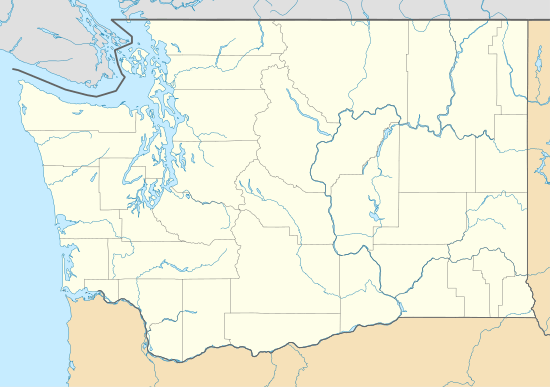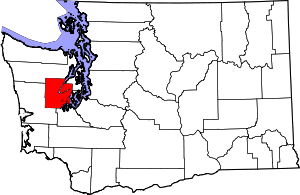Squaxin Island Tribe
The Squaxin Island Indian Reservation is a Native American tribal government in western Washington state in the United States. The Squaxin Island Tribe is made up of several Lushootseed clans living along several inlets of southern Puget Sound:
Squaxin Island Indian Reservation | |
|---|---|
Indian Reservation | |
 South view of the Squaxin Island Administration Building in front of the Reflecting Pond. | |
 Flag | |
| Nickname(s): People of the Water | |
 Squaxin Island Tribe Location in Washington State | |
| Coordinates: 47°12′N 122°55′W | |
| Country | United States |
| State | Washington |
| County | Mason |
| Negotiated | December 26, 1854 |
| Government | |
| • Type | Tribal Council |
| • Chairman | Arnold Cooper |
| • Vice Chairman | Charlene Krise |
| • Secretary | Jeremie Walls |
| • Treasurer | Vicki Kruger |
| • Council | Bev Hawks Dave Whitener Vince Henry |
| Elevation | 207 ft (63 m) |
| Population (2000) | |
| • Total | 405 |
| Time zone | UTC−8 (Pacific (PST)) |
| • Summer (DST) | UTC−7 (PDT) |
| ZIP Code | 98584 |
| Area code(s) | 360 |
| Website | www.squaxinisland.org |
The Squaxin Island people originally spoke the Lushootseed language. They moved onto their reservation in modern-day Mason County, Washington, in 1855. The Squaxin Island Tribe was one of the first Native American tribes in the U.S. to enter into the Self Governance Demonstration Project with the federal government.
The reservation is in southeastern Mason County, Washington. Most of the main reservation is composed of Squaxin Island, but there is also a small part of 26.13 acres (105,700 m2) at Kamilche, in addition to two parcels of off-reservation trust land near Kamilche, as well as a plot of 6.03 acres (24,400 m2) across Pickering Passage from Squaxin Island and a plot of 35.93 acres (145,400 m2) on Harstine Island, across Peale Passage. The total land area including off-reservation trust lands is 6.942 km² (2.68 sq mi, or 1,715.46 acres). Of the total resident population of 405 persons (2000 census), 383 lived in off-reservation trust land to the southeast of Kamilche, and 22 lived on Harstine Island, while the bulk of the reservation's territory, Squaxin Island, was unpopulated.
Paddle to Squaxin Island 2012
The Tribal Journeys began in 1989, intending to coincide with the centennial celebration for Washington State. A total of 9 canoes participated in the "Paddle to Seattle" journey, and in 1993, 23 canoes participated in the "Paddle to Bella Bella". Since 1993, "Tribal Journeys" or "The Paddle" has been held annually, with various tribes serving as the host tribe. A total of 102 canoes landed for the "Paddle to Squaxin Island" journey.
An estimated 40,000 people attended or visited the "Paddle to Squaxin Island" journey, hosted by the Squaxin Museum and The Evergreen State College, and funded by a National Endowment for the Arts "Our Town" grant.[5] Protocol and Dining were held in an old baseball field. The quiet community was loud for a whole week. Months before the event, major construction was done. Many parking lots were made, a campground was built and a Reflecting Pond was put in the Tribal Government Campus.
Tribes from around the country and world attended the event, such as New Zealand, Canada, Alaska, etc.
References
- Parker, Ann (September 2007), "New Native Art Dedicated at TESC Longhouse" (PDF), sgwigwial?tx: News from the Longhouse Education and Cultural Center, Olympia, Washington: The Evergreen State College, p. 3
- Wray, Jacilee, ed. (2013), Native Peoples of the Olympic Peninsula: Who We Are, University of Oklahoma Press, p. 96, ISBN 9780806189963
- Squaxin Library & Museum, Schacht Aslani Architects
- "Modest shellfish mogul, environmental pioneer; Justin Taylor, 1921-2011; Obituary", The Seattle Times, February 23, 2011
- Our Town grant: Olympia, WA: Canoe journey, National Endowment for the Arts, c. 2012, retrieved 2015-04-26
- Squaxin Island Reservation and Off-Reservation Trust Land, Washington United States Census Bureau.
External links
| Wikimedia Commons has media related to Squaxin Island Tribe. |
- Squaxin Island Tribe, official website
- Squaxin Island Tribe history
